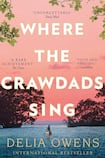
“And then, Kya, only six at the time, heard the screen door slap . . .Who had left the shack? Not Ma. She never let the door slam . . . But when Kya ran to the porch, she saw her mother in a long brown skirt, kick pleats nipping at her ankles, as she walked down the sandy lane in high heels.”
The departure of a mother sets in motion one of the best selling, and most curious books of 2019. Part-murder mystery, part-love story, part-coming of age tale, Where the Crawdads Sing (out in paperback this month) follows the story of Kya, a young girl abandoned to the North Carolina marsh, intertwined with the case of Chase Andrews, a man found dead in a nearby swamp.
At first glimpse, Crawdads might seem like a gentle book. Readers are likely to warm to the exacting, filmic descriptions (Reese Witherspoon’s production company is currently developing the movie). Crabs burying themselves in the swash, the moon “pull[ing] herself naked from the waters”, mud holes revealing “a profusion of detailed stories”; the natural world is brought intensely to life. But if this is a gentle book, it is only as gentle as an animal, as gentle as the weather, as gentle as the tide: which is to say that beneath everything, there is a wild and dangerous energy.
Vulnerable yet dangerous
That first departure plants a hurt in Kya that will not relent. It also dissolves the family unit: Kya’s brother and father eventually flee, and she is left feral in the marsh. Absence creates stakes the reader might barely notice. Kya’s aloneness is charged: she is helpless yet resourceful, vulnerable yet dangerous. The townspeople derisively call her “Marsh girl”. Abandoned, objectified – you could draw comparisons to the princess in the tower, the madwoman in the attic. Perhaps most accurately, you might call her Mowgli, that famed jungle kid, raised by the land and the animals. “Every morning she woke early, still listening for the clatter of Ma’s busy cooking . . . Until at last . . . Kya laid her hand upon the breathing, wet earth, and the marsh became her mother.”
Ultimately, I think the book needs this 'more-ness' to live up to the hype around it. It was good but not 3.6 million copy best-seller good
That early theme of motherhood is a salient one, and it is linked to many others as the book goes on. I suspect that were the mother character present, she would not seem as complex or visible. If this is true, it raises a question about how we see mothers in general. And this is not the only question raised by the book. Part of its draw is how readily it engages with contemporary themes – not just motherhood, but femaleness, loneliness, personhood, society. What does it mean to be raised and taught, to comply with rules and/or be victimised by rules, to live among others, and/or be excluded by others? You could call Crawdads a raging feminist manifesto, a seething commentary on small town tribalism/racism, a cry for ecological action.
Poacher case
Admittedly, I was also enchanted by extra-textual elements. Google the author (if you don’t find nosiness about authors’ lives to be crass). Her name is Delia Owens and like her main character, she is a wildlife scientist who has published award-winning nature books. In 2010, along with her then husband, she was the subject of a New Yorker piece about the murder of a poacher in Zambia. You’ll be likely to dredge up such results such as “Is where the crawdads sing a true story?” I should clarify that Owens isn’t a suspect in the murder case, but I will admit to feeling perversely tickled by these details. When a book becomes this big (it has sold more than 3.6 million copies to date), it becomes more than the words between its covers.
Ultimately, I think the book needs this “more-ness” to live up to the hype around it. It was good but not 3.6 million copy best-seller good. Some of the plot twists felt false and cheap. There were parts of the murder case that seemed forced – the police detectives often came across as overly obtuse, in a trade-off for suspense.
Still, the main character will stay with me. I liked her animal-like movements, her hermit state. I liked her unique position in the world: something barely subject to human contact, yet which could not fully denounce her humanness: a humanness that would inevitably lead to yearning, love and – most prominently for Kya – pain. And I liked how in the face of such pain, there was every chance she might become, like any human animal, a deadly and ferocious beast.












